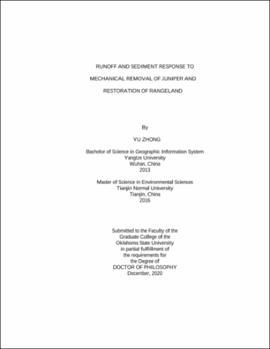| dc.contributor.advisor | Zou, Chris B. | |
| dc.contributor.author | Zhong, Yu | |
| dc.date.accessioned | 2021-05-25T20:32:23Z | |
| dc.date.available | 2021-05-25T20:32:23Z | |
| dc.date.issued | 2020-12 | |
| dc.identifier.uri | https://hdl.handle.net/11244/329946 | |
| dc.description.abstract | This dissertation examines runoff and sediment responses to restoring woody plant encroached rangeland in the south-central Great Plains using the paired watershed approach, before-after control-impact (BACI) analysis, and soil and water assessment tool (SWAT) to answer three different but closely related research questions: | |
| dc.description.abstract | i) Will the soil moisture dynamics and runoff patterns recover after mechanical removal of juniper (Juniperus virginiana L., redcedar) and restoration to native prairie or establishment of switchgrass (Panicum virgatum L.)? Analysis based on a paired watershed approach showed that the root zone soil water storage increased by 1.6 and 1.9 times for restored prairie and switchgrass, respectively, after juniper removal. The restored prairie and switchgrass production system increased annual runoff by 4.46 and 4.54 times, respectively. | |
| dc.description.abstract | ii) What level of soil erosion will be caused by the mechanical removal of juniper, and how will the soil erosion of restored grasslands compare with the juniper woodland? The BACI analysis concluded that mechanical removal itself resulted in a limited but significant increase of sediment yield in the year after removal. However, a pulsed increase of sediment load occurred with the herbicide application to plant switchgrass in the following year. After grasslands were established, the sediment load was very low, but the switchgrass biomass production system had a lower average sediment concentration and sediment yield than the restored prairie. | |
| dc.description.abstract | iii) How will juniper removal followed by switchgrass planting affect runoff and sediment yield at a regional scale? The scenario simulation using SWAT model showed that the conversion of juniper to switchgrass had limited impacts on annual water budget and sediment yield at the basin level of the Lower Cimarron River (LCR) basin; however, this transformation had local effects on ET and streamflow in subbasin with high juniper cover (14% of LCR). Converting juniper and marginal rangelands to switchgrass resulted in 1.3 - 3.5% increase of annual ET and 5.4 - 13.5% decrease in annual streamflow, with 12.2 - 61.6% reduction in sediment yield. The increase of ET and reduction of streamflow were greatest during the switchgrass growing season. | |
| dc.format | application/pdf | |
| dc.language | en_US | |
| dc.rights | Copyright is held by the author who has granted the Oklahoma State University Library the non-exclusive right to share this material in its institutional repository. Contact Digital Library Services at lib-dls@okstate.edu or 405-744-9161 for the permission policy on the use, reproduction or distribution of this material. | |
| dc.title | Runoff and sediment response to mechanical removal of juniper and restoration of rangeland | |
| dc.contributor.committeeMember | Will, Rodney E. | |
| dc.contributor.committeeMember | Kharel, Gehendra | |
| dc.contributor.committeeMember | Ochsner, Tyson E. | |
| osu.filename | Zhong_okstate_0664D_17026.pdf | |
| osu.accesstype | Open Access | |
| dc.type.genre | Dissertation | |
| dc.type.material | Text | |
| dc.subject.keywords | eastern redcedar | |
| dc.subject.keywords | land use management | |
| dc.subject.keywords | oklahoma | |
| dc.subject.keywords | switchgrass | |
| dc.subject.keywords | tallgrass prairie | |
| thesis.degree.discipline | Natural Resource Ecology and Management | |
| thesis.degree.grantor | Oklahoma State University | |
